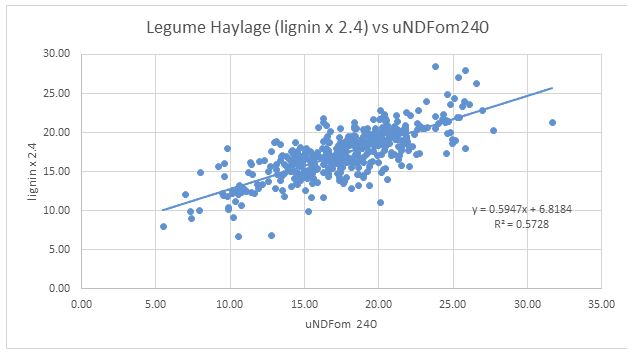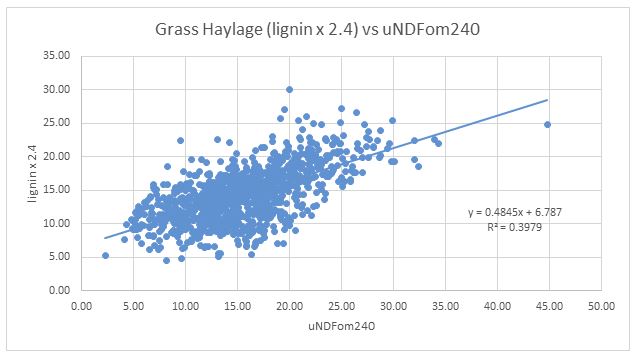|
|
| |
| The Alphabet Soup of Fiber
Paul Sirois, Manager,
Dairy One/Equi-analytical Laboratories
If you are tired of reading about the new world of fiber and the myriad of abbreviations, i.e., aNDF, aNDFom, uNDFom30, NDFDom240, etc., then skip down to the next article. Otherwise, get geeked out on the following!
As we strive to better understand fiber digestion and kinetics, it is important to determine how much fiber is potentially digestible and therefore, potentially undigestible. In previous versions of the CNCPS model, the undigestible fiber was calculated as [lignin x 2.4]. This equation/relationship was used across all forage types. Research at Cornell over the last few years found that this relationship varied by forage type and was better determined by measuring undigestibility at 240 hours (uNDFom240). This is important because the undigestible fiber plays a key role in the determination of the rate of fiber digestion (kd).
In the following graphs, we compared the undigestible fiber calculated as [lignin x 2.4} vs. the measured undigestible fiber at 240 hours (uNDFom240) for corn silage (n=1171), legume haylage (n=419) and grass haylage (n=1083).



The graphs illustrate the amount of variation both within and across feed types. Using this data, we also calculated the digestibility constant [uNDFom240/lignin] for each sample. The average calculated constants for corn silage, legume haylage and grass haylage were 2.78 +/- 0.58, 2.45+/-0.40 and 2.68+/-0.84, respectively. The calculated legume constant of 2.45 very closely approximated the fixed constant of 2.4. However, it is clear from the graphs that there is a large amount of variation and a measured digestibility of uNDFom240 will lead to better rate estimations as opposed to approximating the value using a fixed constant.
|
| NY State Fair Hay Contest
The New York State Fair is August 27th to September 7th and serves as a great showcase for modern agriculture. Where else can you go to see multiple breeds of dairy cattle, beef cattle, horses, sheep, goats and more? These all represent the finest of their breeds as they vie to be Grand Champions of the Great NY State Fair. Not only will you see animals, there are also competitions for fruits, vegetables, flowers and field crops - particularly hay. If you're a farmer, here's a chance to show off all of your hard work to manage and put up high quality forages. Likewise, if you're employed in agri-service and know of a farmer who puts up excellent forage year after year, encourage them to enter the Hay contest. The March Newsletter had the results of the 2014 Hay Contest.
The entry deadline for 2015 is rapidly approaching.
ENTRY DEADLINE: 4:30 p.m. on July 31, 2015.
Exhibitor Fee: $10.00 (includes an analysis from the Dairy One Forage Lab)
Entries for the contest must be delivered on Wednesday, August 26 from 11:00 a.m. - 9:00 p.m. The hay exhibit is right next to the immensely popular baked potato stand.
Here are a few things to keep in mind:
1. The hay crop must have been planted prior to 2015.
2. An entry shall consist of one whole small bale of hay tied or a minimum of 25# maximum of 50# from a large bale in a plastic-lined box. Hay will become property of the Fair and will not be returned at completion of the Fair.
3. Hay entries with moisture content above 25% will be disqualified.
4. In judging the hay entries, a scorecard will be used to evaluate physical features which include: lack of mold/odor, freedom of foreign material, maturity, leaf retention, and color. Another 50 points will be based on forage quality analyses which will be determined by Dairy One Forage Lab. The forage quality analyses will include dry matter (DM), neutral detergent fiber (NDF), crude protein (CP) and digestible neutral detergent fiber (NDFd).
There are classes for conventional and organic hay. Following are the classes:
1. Alfalfa - first cutting
2. Alfalfa - first cutting acid treated
3. Alfalfa - later cuttings
4. Alfalfa - later cuttings acid treated
5. Alfalfa - Grass Mix - first cutting
6. Alfalfa - Grass Mix - later cutting
9. Other species (other than grass and alfalfa such as red clover, trefoil, etc.)
There are also classes for both conventional and organic silages. For these entries:
1. Entries should fill and be tightly packed into an airtight 3 to 4 gallon plastic bag. At the exhibit site, the entries will be transferred to a uniform container.
2. Corn silage entries must have been grown by exhibitor in 2014.
3. Haylage may have been grown in 2014 and 2015.
10. Corn silage - whole plant ensiled (2014 crop) BMR (brown midrib)
11. Corn Silage - whole plant ensiled (2014 crops) non-BMR
12. Kernel processed corn silage (2014 crop)
13. High moisture corn grain - stored in silo (2014 crop)
14. High moisture ground ear corn - stored in silo (2014 crop)
15. ALL Haylage - except class 10
16. Haylage - small grain haylage (any small grain - wheat, barley, etc.)
Detailed entry information and rules are available on the NY State Fair website. Hope to see your feed at the NY State Fair!
|
| Meet the Forage Lab Staff: Heidi Jackson, Forage Lab Support Technician
My name is Heidi Jackson and I work as the Forage Lab Support Technician. I started at Dairy One working in the Forage Lab sample receiving and prep area. There, I learned all of the kind codes and service codes for samples arriving at the lab. We have over 450 kind codes used to identify the wide variety of samples that we analyze. The service codes are used to identify the different packages and individual analyses. Identifying and assigning the kind and service codes is the first step in the analytical process. This was valuable experience as it formed the foundation for understanding the entire forage lab system. My other responsibilities included performing dry matter determinations and grinding the samples in preparation for subsequent analyses.
 Next I went to work in the Special Services area. Special Services is unique in that it covers a broad range of analyses. I performed starch, WSC, ESC, fat (ether extraction & acid hydrolysis), mycotoxins, nitrates, pH, VFA, ash, acid insoluble ash, chloride and water analyses. I worked in this capacity for 15 years, then took the position of NIR Senior Technician where I was responsible for the daily analysis and throughput of samples by NIR. I performed NIR analyses for 2 years before assuming my role as Lab Support Technician. My major responsibility is to fill in and help out wherever needed. Thus, I get to work in all areas of the lab when people are out on vacation, sick or need extra help. In this role, in addition to my prior experience, I learned bomb calorimetry, ADF, NDF, lignin, in vitro and minerals analyses. I also assist the Lab Safety and Quality Assurance director with routine inspections of fire extinguishers, ventilation hoods and balances.
Lastly, I attended "Edit School", an internal program where I learned about the nutrient composition of forages. This was the "icing on the cake" as it pulled together all of the analyses that I learned, how they relate to one another and how to interpret the collective final results. As an editor, I'm qualified to review and approve results prior to release.
As Lab Support Technician, no two days are ever the same. This is what I like about my role at Dairy One: I get to something different every day and enjoy the opportunity to work with the entire staff. I've been employed by Dairy One for 22 years and like the friendly open environment and the opportunity to grow and learn new things. Outside of work, I enjoy my spending time with my family and raising my kids.
|
|
| |

Dairy One - Forage Laboratory
730 Warren Road ~ Ithaca, NY ~ 14850
Phone: 1-800-344-2697 Ext. 2172
|
|
|
|